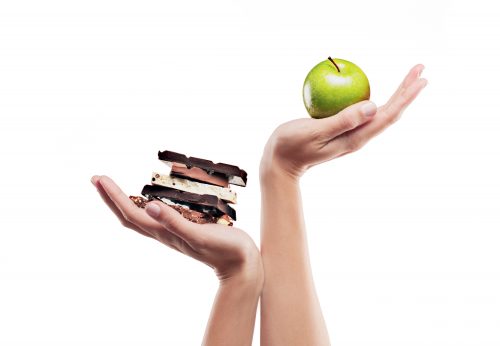
Willpower is something many of us battle with, but the latest findings show increasing your willpower is not as hard as you may have thought. Dr William Sukala shows you how.
We can be our own worst critics at times. One little slip of the diet and nobody comes down harder on us than ourselves.
That little voice in the back of our head chimes in: ‘Why did I have that second serve of ice-cream?’, ‘Why did I have to keep eating that delicious pasta, now I could burst!’ or ‘Why can’t I just have one piece of chocolate, instead of devouring the entire block?’ Then we chide ourselves for a hopeless lack of willpower. Sound familiar?
Science now has a greater understanding of how our willpower works, which we can use to help improve and master our self-control.
Where we may have imagined willpower to be something like an iron shutter that we mentally pull on to make the right choices, willpower is in fact the result of a number of internal factors (such as your hormones). These factors at any given moment can contribute to how much willpower we have.
The good news is you’re not necessarily a prisoner to your biology. The following practical steps can help you to whip your willpower into shape, and free you from feelings of self-blame.
Diets are your willpower’s worst enemy
Many popular diets focus on kilojoule restriction which, from a willpower perspective, may actually work against you. This is because your brain uses blood sugar from food as its primary fuel source. So, the more you restrict yourself and the food you eat, the more you deplete your blood sugar levels, which in turn makes it harder to make healthy food choices later.
Restoring and maintaining stable blood sugar levels can improve your self-control and reduce impulse decisions.
Dieting also alters your hunger and satiety hormones, namely ghrelin and leptin. Ghrelin sends signals to the brain that stimulate your appetite, whereas leptin tells you to put down the fork.
Dr Amanda Sainsbury-Salis, Research Fellow at the Boden Institute of Obesity, Nutrition, Exercise, and Eating Disorders (in Sydney), says “chemical changes occur in the brain in response to several weeks or months of dieting, increased exercise, or both.
“In the face of elevated ghrelin and reduced leptin levels, resisting hunger can be extremely difficult.”
Action steps
- Avoid the crash diets and eat a nutrient-dense diet which includes wholegrains, vegetables, fruits, and lean protein sources such as chicken and fish. It’s also important to eat foods with a lower glycaemic index (GI), such as brown rice, multigrain bread or quinoa, because they tend to leave the stomach slowly and give a more sustained rise in energy.
- Refined foods such as biscuits, cakes, puffed-rice cereals, white bread and chips, lead to ‘boom and bust’ cycles. These are rushes of energy followed by slumps, which leave you craving another energy fix.
- Spacing meals out over the day and allowing yourself a healthy snack (such as a piece of fruit or a tub of low-fat yoghurt) when you feel hungry will help to maintain stable energy levels.
- Ignoring a growling tummy will only leave you open to overeating at your next meal. So it’s better to acknowledge hunger and have a small snack.
- Watch your alcohol intake, too, as this can reduce blood sugar levels and leave you more prone to cravings.
Meditation improves willpower
Meditation can change both the structure and function of the brain to enhance components of willpower such as attention, focus, stress management, impulse control and self-awareness.
In a 2007 Chinese study, subjects performed 20 minutes of meditation and mindfulness techniques each day for five days. They experienced improved efficiency in how the brain focuses its attention, which resulted in better emotional regulation.
Participants also had more vigour and less anxiety, depression, anger and fatigue (which can all impinge on your self-control).
Action steps
- Learning how to calm the internal mental ‘chatter’ can help when you’re faced with tricky eating choices. Try to practise mindfulness. Stop for a moment before eating. Get rid of TV, internet and cell phone distractions. Concentrate for a moment on your food.
- Take small mouthfuls and try to slow down your eating to be aware rather than wolfing food down without thinking.
- Even five minutes of daily meditation can have benefits. New to meditation? Look for a meditation course in your area (or look online).
Simple goals work best for willpower
Dr. Roy Baumeister at Florida State University in the US has shown willpower can be trained like your triceps but can become temporarily weakened by trying to achieve too many tasks at once.
In order to maximise the benefits of willpower, let your brain tackle one goal at a time rather than attempt to tame 10.
Action steps
- Tuning into your hunger is a good, simple goal to start with. Aim to listen to your body, and only eat when you are physically hungry. Don’t worry about the clock or that it’s ‘time’ to eat. See how this changes your habits.
- Once you’re in tune with your hunger, tackle your portion sizes. Swap to a smaller plate for every meal. Don’t measure or weigh any food.
- Another simple and powerful goal is to add one more colourful vege serve to every meal. This will fill you up, add valuable nutrients and help you feel great.
Exercise can boost willpower
Physical exercise has been shown to improve health on many fronts, including willpower. In a 2006 study at Macquarie University in Sydney, subjects performed regular gym exercise (aerobic exercise and weight training) for four months. They reported an increase in their emotional control, attendance to commitments and healthy eating. They ate less ‘junk’ food and reduced their caffeine and alcohol intake.
Action steps
- If you struggle to find the willpower to start exercising, think of exercise as incidental — part of your daily routine.
- Consider walking to work, or going for a walk in your lunch break.
- During the day, try to maximise the time you spend on your feet – this ‘background’ movement has been shown to help keep weight under control and improve general health. Have ‘stand-up’ meetings or ‘walk and talk’ instead of sitting at a table.
- Identify the time of day you feel the most energetic and plan to exercise then. Aim for 30 minutes a day of accumulated exercise – it doesn’t have to be all in one go.
- If a busy family life stops you exercising, find ways to get moving together. Go walking or biking, or invest in a fitness computer game you can play together.
Tiredness reduces self-control
There really is no substitute for a good night’s sleep. A 2010 report published in Progress in Brain Research suggests brain regions involved in willpower and decision making are susceptible to sleep deprivation.
Though the specifics are not yet fully understood, impairments in the brain’s higher reasoning centres may reduce your control over cravings when you’re tired.
Most of us need around seven or eight hours of sleep a night. If you’re getting this but you still don’t feel refreshed on waking, you may not be going into the important deep part of the sleep cycle which we all need. Inadequate deep sleep can make us feel constantly fatigued.
Action steps
- Caffeine and alcohol won’t stop you from getting to sleep – but they do stop you from going into deep restorative sleep. Limit your coffees to one or two a day, and don’t have any in the afternoon. If you’re very stressed, consider cutting it out altogether.
- Get outside every day – natural daylight stimulates melatonin which helps regulate your sleep cycle.
- Leave at least an hour between eating and going to bed so your body isn’t busy digesting food when you’re trying to sleep.
Brainy business
Specific regions of the brain are associated with willpower and work in concert to help you make important decisions like choosing healthy foods and exercising. The more you 'exercise' these brain structures, the more you strengthen the neural connections that reinforce self-control and, consequently, your success with healthful eating and exercise.
The prefrontal cortex (PFC) is the brain’s executive function centre which is involved in planning behaviours and making decisions. The right prefrontal cortex is the 'finger wagging' side telling you 'Look, cheesecake, bad choice', while the left side says 'Ooh, fresh salad, good choice.'
Another region, the ventromedial prefrontal cortex, is involved in planning and decision making and helps guide you through the daily barrage of choices: 'Do I go for a walk or check email? Should I eat a biscuit or an apple?'
The anterior cingulate cortex (ACC) moderates the conflict between what you intended to do (eg. exercise and eat healthy) and what you’re actually doing (eg. sitting on the couch eating ice cream). It perceives the craving for an unhealthy lifestyle choice and then presents the pros and cons for each decision.
These brain structures work in concert. For example, your ventromedial PFC sets your healthy eating plan in motion, but when you’re confronted with an all-you-can-eat buffet, your ACC assumes the role of internal peacemaker to moderate the conflict between 'do I gorge on the quiche or opt for a sensible portion of healthy choices instead?' Your right PFC then hits the brakes on the quiche, allowing your left PFC to move you towards the salad bar.
This sort of brain sequence, that leads you away from temptation and towards positive choices, can be strengthened with practice. By using the action steps outlined here, your positive thought patterns will start to become well-trodden pathways, and you will find that making healthy choices is no longer a mental battleground.
www.healthyfood.com










